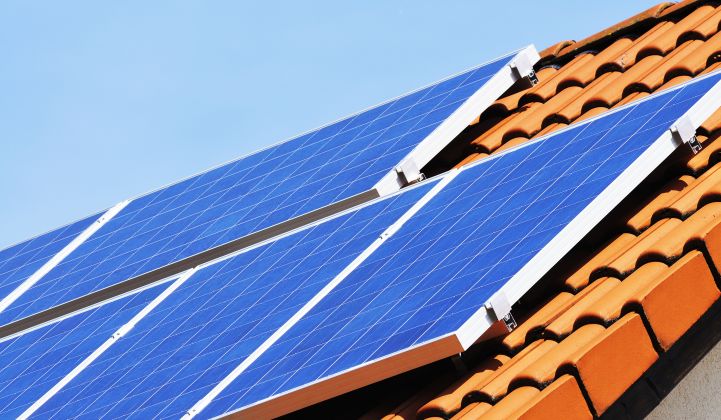If you can’t beat ‘em, join ‘em.
That’s the thinking behind the push by several European electric utilities to offer PV systems combining rooftop panels, energy management technology and battery storage, thus allowing consumers to maximize consumption of the electricity they produce.
In June, France’s EDF became the latest to jump onto the self-consumption bandwagon, joining German utilities E.ON and RWE, as well as Swedish utility Vattenfall. The trend shows just how difficult life has become for traditional generators as the cost of rooftop solar power reaches parity with grid electricity -- they’re all trying to figure out how to offer new services.
“From the utility perspective, what they’re ultimately doing is making customers produce their own electricity and not buy from the utility, destroying the utility business model,” said Marcel Münz, an energy industry advisor with PA Consulting in Frankfurt, Germany. “But margin in the retail business is so low that they have to act somehow and find new ways of creating value.”
Third-party PV and storage are eating away at the demand for grid energy. Falling feed-in tariffs -- in Germany, tariffs fell by 30 percent to 40 percent between 2013 and 2014 -- make it less attractive for consumers to interact with the grid.
“Utilities feel their traditional business models aren’t working anymore,” said Münz. Utilities have the choice of competing with their own self-consumption offerings -- or being left behind.
EDF has shown its commitment to self-consumption by eliminating its existing rooftop solar business in favor of the new offering, which will be marketed under the name Mon Soleil & Moi. However, battery storage isn’t part of the default package from most utilities. This limits the potential for self-consumption -- although energy management systems that can coordinate household electricity consumption with peak PV output are included.
“It doesn’t always make sense to invest in battery storage from a residential point of view, but it is improving,” said Münz. “But as battery prices fall 10 percent to 15 percent each year through 2020, by the beginning of 2018 it will be more attractive to have this component.” In Germany, which has been an early leader in storage, 41 percent of solar systems installed in 2015 had battery backup.
A sun-bathed home that’s outfitted with a self-consumption system complete with battery backup and energy management technology can get as much as 80 percent of its electricity from rooftop PV, compared to 25 percent for PV alone.
For now, EDF sells the systems to residential buyers, while E.ON and RWE offer PPA-style contracts that typically last 18 years.
In the long run, utilities may prefer to offer leases that provide “a constant revenue stream, and the utility can charge margins on the entire value chain,” Münz said. “This is the model that will be most promising in the future.”
Solar lease revenue can compare favorably with the revenue utilities receive from the traditional sale of grid electricity. In Germany, where self-consumption is becoming increasingly popular, a typical home that consumes 3,000 kilowatt-hours per year might pay 50 euros per month for a 5-kilowatt rooftop solar system with energy management.
Utility profits, on the other hand, will be slimmer.
“Costs are much higher,” said Olaf Remmler, an energy and technology expert with PA Consulting in Hamburg, Germany. “To achieve 50 euros of monthly revenue, the utility has to deal with many stakeholders and panel manufacturers. There are significant costs along the whole supply chain.”
This illustrates the stark reality faced by many European electric utilities: Demand for grid power is falling and competition for a piece of the shrinking retail electricity pie is intense.
“Large utilities in Europe have to do this because they see innovators entering the market and residential customers are buying these services," said Münz.
“It’s clear that this business model isn’t able to cover all revenues they lose from their old business model,” he said. “There is no other chance for utilities to maintain their business model and not lose market share.”
In the long run, the utilities might be planning for a day when they own and dispatch a critical mass of residential battery storage, enabling them to act as aggregators of distributed resources to be sold into wholesale electricity markets, and providing a hedge against a declining revenue stream.
“What we might see in the future is utilities offering storage on some leasing model with a continuous revenue stream,” said Brett Simon, a storage analyst with GTM Research.
For utilities, the choice is clear: adopt new business models around self-consumption and storage, or let someone else do it.
“Rather than lose this revenue stream, they get into it with the intent of at least holding onto these customers,” said Ravi Manghani, director of GTM Research’s storage practice.
There are 800 German utilities competing among themselves to provide electricity to retail customers -- and also against a rising tide of outsiders like PV and battery manufacturers, aggregators and others who see opportunity to disrupt the country’s electricity sector.
At the same time, consumers have more reasons to take electricity production into their own hands. Germany requires that newly built homes meet mandatory renewable energy targets of 20 percent to 25 percent, which can be met by rooftop PV. Homeowners are further incentivized to self-consume by the differential between the cost of grid electricity and feed-in tariffs: Power from the grid costs around 30 euro cents per kilowatt-hour, while the feed-in tariff has fallen to 12 euro cents.
Utility ownership of legacy residential customer relationships may provide a competitive advantage against newcomers to the market. In the big picture, self-consumption is one part of their “combination of defensive and offensive strategies,” said Manghani.
The move to self-consumption is underway in other highly competitive electricity markets, notably in the Netherlands and the U.K. By comparison, the practice has lagged in sun-drenched Spain and Italy, where utilities still charge a fee for self-consumption.



